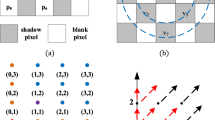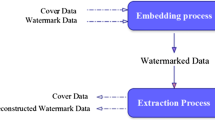Abstract
Prediction-error expansion (PEE) is an important technique for reversible watermarking (RW). Traditional PEE methods exploit pixel correlations by modifying prediction-error histogram (PEH) with Laplacian-like distributions, but they rarely consider the influence of needless shifting on image distortion. Asymmetric PEE approaches utilize skewed PEHs to select fewer shifted pixels for superior performance in capacity-distortion control tasks. In this way, the construction of a suitable extreme predictor is especially useful for increasing embedding capacity and reducing image distortion to satisfy user requirements. However, in recent works, the parameters of extreme predictors were not fully optimized. This paper presents a novel extreme predictor, in which the prediction parameters are optimized by using a differential evolution (DE) algorithm to increase the performance of asymmetric PEE by building a sharp and skewed PEH. Specifically, we develop a new DE algorithm based on hybrid mutation and grouping crossover operations to further improve the optimization accuracy of the algorithm. Then, an RW scheme based on the proposed predictor and image separation is built to fully exploit the embedding potential of different bit-planes in images. To reduce image distortion, a strategy that is complementary to double-embedding is presented for lower bit-plane (LBP) embedding. Experimental results demonstrate that the proposed scheme can achieve better image quality and a larger embedding capacity than similar state-of-the-art methods.










Similar content being viewed by others
Explore related subjects
Discover the latest articles and news from researchers in related subjects, suggested using machine learning.References
Weng SM, Shi YQ, Hong W, Yao Y (2019) Dynamic improved pixel value ordering reversible data hiding. Inf Sci 489:136–154. https://doi.org/10.1016/j.ins.2019.03.032
Luo L, Chen Z, Chen M, Zeng X, Xiong Z (2010) Reversible image watermarking using interpolation technique. IEEE Trans Inf Forensic Secur 5(1):187–193. https://doi.org/10.1109/TIFS.2009.2035975
Parah SA, Sheikh JA, Akhoon JA, Loan NA (2020) Electronic health record hiding in images for smart city applications: a computationally efficient and reversible information hiding technique for secure communication. Futur Gener Comput Syst 108:935–949. https://doi.org/10.1016/j.future.2018.02.023
Bhardwaj R, Aggarwal A (2021) An enhanced separable reversible and secure patient data hiding algorithm for telemedicine applications. Expert Syst Appl 186:115721. https://doi.org/10.1016/j.eswa.2021.115721
Carpentieri B, Castiglione A, De santis A, Palmieri F, Pizzolante R (2019) One-pass lossless data hiding and compression of remote sensing data. Fut Gener Comput Syst 90:222–239. https://doi.org/10.1016/j.future.2018.07.051
Qin C, Jiang C, Mo Q, Yao H, Chang CC (2021) Reversible data hiding in encrypted image via secret sharing based on GF(p) and GF(28). IEEE Transactions on Circuits and Systems for Video Technology. https://doi.org/10.1109/TCSVT.2021.3091319
Puteaux P, Puech W (2021) A recursive reversible data hiding in encrypted images method with a very high payload. IEEE Trans Multimed 23:636–650. https://doi.org/10.1109/TMM.2020.2985537
Wang X, Chang CC, Lin CC (2021) Reversible data hiding in encrypted images with block-based adaptive MSB encoding. Inf Sci 567:375–394. https://doi.org/10.1016/j.ins.2021.02.079
Thodi DM, Rodriguez JJ (2007) Expansion embedding techniques for reversible watermarking. IEEE Trans Image Process 16(3):721–730. https://doi.org/10.1109/TIP.2006.891046
Roy A, Chakraborty RS (2020) Toward optimal prediction error expansion-based reversible image watermarking. IEEE Trans Circ Syst Video Technol 30(8):2377–2390. https://doi.org/10.1109/TCSVT.2019.2911042
Fallahpour M (2008) Reversible image data hiding based on gradient adjusted prediction. IEICE Electron Express 5(20):870–876. https://doi.org/10.1587/elex.5.870
Coltuc D (2011) Improved embedding for prediction-based reversible watermarking. IEEE Trans Inf Forensic Secur 6(3):873–882. https://doi.org/10.1109/TIFS.2011.2145372
Sachnev V, Kim HJ, Nam J, Suresh S, Shi YQ (2009) Reversible watermarking algorithm using sorting and prediction. IEEE Trans Circ Syst Video Technol 19 (7):989–999. https://doi.org/10.1109/TCSVT.2009.2020257
Ou B, Li X, Zhao Y, Ni R (2013) Reversible data hiding based on pde predictor. J Syst Softw 86(10):2700–2709. https://doi.org/10.1016/j.jss.2013.05.077
Dragoi I, Coltuc D (2014) Local-prediction-based difference expansion reversible watermarking. IEEE Trans Image Process 23(4):1779–1790. https://doi.org/10.1109/TIP.2014.2307482
Zheng H, Wang C, Wang J, Xiang S (2019) A new reversible watermarking scheme using the content-adaptive block size for prediction. Sign Process 164:74–83. https://doi.org/10.1016/j.sigpro.2019.05.035
Hwang HJ, Kim S, Kim HJ (2016) Reversible data hiding using least square predictor via the lasso. EURASIP J Image Video Process 42:1687–5281. https://doi.org/10.1186/s13640-016-0144-3
Wang W, Wang C, Zheng H, Wang J, Xiao D (2020) An improved reversible watermarking scheme using weighted prediction and watermarking simulation. Sign Process Image Commun 81:115705. https://doi.org/10.1016/j.image.2019.115705
Chen X, Sun X, Sun H, Zhou Z, Zhang J (2013) Reversible watermarking method based on asymmetric-histogram shifting of prediction errors. J Syst Softw 86:2620–2626. https://doi.org/10.1016/j.jss.2013.04.086
Kim S, Qu X, Sachnev V, Kim HJ (2019) Skewed histogram shifting for reversible data hiding using a pair of extreme predictions. IEEE Trans Circ Syst Video Technol 29(11):3236–3246. https://doi.org/10.1109/TCSVT.2018.2878932
Wang W, Ye J, Wang T, Wang W (2017) Reversible data hiding scheme based on significant-bit-difference expansion. IET Image Process 11:1002–1014. https://doi.org/10.1049/iet-ipr.2017.0151
Kumar R, Jung KH (2020) Robust reversible data hiding scheme based on two-layer embedding strategy. Inf Sci 512:96–107. https://doi.org/10.1016/j.ins.2019.09.062
Chang CC, Kieu TD (2010) A reversible data hiding scheme using complementary embedding strategy. Inf Sci 180(16):3045–3058. https://doi.org/10.1016/j.ins.2010.03.027
Lu TC, Tseng CY, Wu JH (2016) Asymmetric-histogram based reversible information hiding scheme using edge sensitivity detection. J Syst Softw 116:2–21. https://doi.org/10.1016/j.jss.2015.04.085
Storn R, Price K (1997) Differential evolution – a simple and efficient heuristic for global optimization over continuous spaces. J Glob Optim 11:341–359. https://doi.org/10.1023/A:1008202821328
Ali M, Ahn CW (2014) An optimized watermarking technique based on self-adaptive de in dwt–svd transform domain. Signal Process 94:545–556. https://doi.org/10.1016/j.sigpro.2013.07.024
Lei B, Tan EL, Chen S, Ni D, Wang T, Lei H (2014) Reversible watermarking scheme for medical image based on differential evolution. Expert Syst Appl 41 (7):3178–3188. https://doi.org/10.1016/j.eswa.2013.11.019
Vali MH, Aghagolzadeh A, Baleghi Y (2018) Optimized watermarking technique using self-adaptive differential evolution based on redundant discrete wavelet transform and singular value decomposition. Expert Syst Appl 114:296–312. https://doi.org/10.1016/j.eswa.2018.07.004
Salimi L, Haghighi A, Fathi A (2020) A novel watermarking method based on differential evolutionary algorithm and wavelet transform. Multimed Tools Appl:1–18
Yi S, Zhou Y (2018) Parametric reversible data hiding in encrypted images using adaptive bit-level data embedding and checkerboard based prediction. Sign Process 150:171–182. https://doi.org/10.1016/j.sigpro.2018.04.016
Zhou S, Zhang W, Shen C (2020) Rate-distortion model for grayscale-invariance reversible data hiding. Sign Process 107562:172. https://doi.org/10.1016/j.sigpro.2020.107562
Chen X (2020) Novel dual-population adaptive differential evolution algorithm for large-scale multi-fuel economic dispatch with valve-point effects. Energy 117874:203. https://doi.org/10.1016/j.energy.2020.117874
Loshchilov I, Hutter F (2017) Sgdr: Stochastic gradient descent with warm restarts. 5th International Conference on Learning Representations (ICLR 2017)
Khalfi S, Draa A, Iacca G (2021) A compact compound sinusoidal differential evolution algorithm for solving optimisation problems in memory-constrained environments. Expert Syst Appl 115705:186. https://doi.org/10.1016/j.eswa.2021.115705
Xia X, Tong L, Zhang Y, Xu X, Yang H, Gui L, Li Y, Li K (2021) NFDDE: A novelty-hybrid-fitness driving differential evolution algorithm. Inf Sci 579:33–54. https://doi.org/10.1016/j.ins.2021.07.082
Li Y, Wang S (2019) Differential evolution algorithm with elite archive and mutation strategies collaboration. Artif Intell Rev:1–46
Brest J, Greiner S, Boskovic B, Mernik M, Zumer V (2006) Self-adapting control parameters in differential evolution: a comparative study on numerical benchmark problems. IEEE Trans Evol Comput 10(6):646–657. https://doi.org/10.1109/TEVC.2006.872133
Tanabe R, Fukunaga A (2013) Success-history based parameter adaptation for differential evolution. In: 2013 IEEE Congress on evolutionary computation, pp 71–78. https://doi.org/10.1109/CEC.2013.6557555
He X, Zhou Y (2018) Enhancing the performance of differential evolution with covariance matrix self-adaptation. Appl Soft Comput 64:227–243. https://doi.org/10.1016/j.asoc.2017.11.050
Yu X, Li C, Zhao WX, Chen H (2020) A novel case adaptation method based on differential evolution algorithm for disaster emergency. Appl Soft Comput 92:106306. https://doi.org/10.1016/j.asoc.2020.106306
Deng LB, Li CL, Sun GJ (2020) An adaptive dimension level adjustment framework for differential evolution. Knowl-Based Syst 206:106388. https://doi.org/10.1016/j.knosys.2020.106388
Lin SL, Huang CF, Liou MH, Chen CY (2013) Improving histogram-based reversible information hiding by an optimal weight-based prediction scheme. J Inf Hiding Multimed Signal Process 4(1):19–33
Acknowledgements
This work was supported by the Hainan Province Basic and Applied Basic Research Program High-level Talent Project (No. 2019RC044) and the Research Project of Education and Teaching Reform of Hainan University (No. hdjy2053).
Author information
Authors and Affiliations
Corresponding author
Ethics declarations
Conflict of Interests
The authors declare that they have no conflict of interest.
Additional information
Publisher’s note
Springer Nature remains neutral with regard to jurisdictional claims in published maps and institutional affiliations.
Rights and permissions
About this article
Cite this article
Zhuang, Y., Liu, S., Ding, C. et al. Reversible watermarking based on extreme prediction using modified differential evolution. Appl Intell 52, 14406–14425 (2022). https://doi.org/10.1007/s10489-022-03211-1
Accepted:
Published:
Issue Date:
DOI: https://doi.org/10.1007/s10489-022-03211-1




